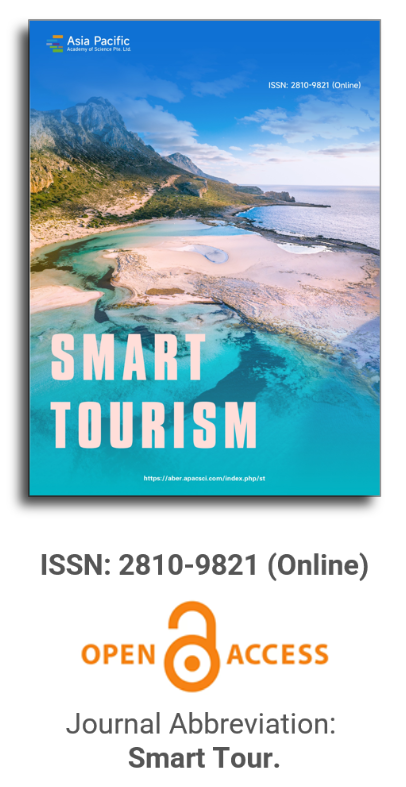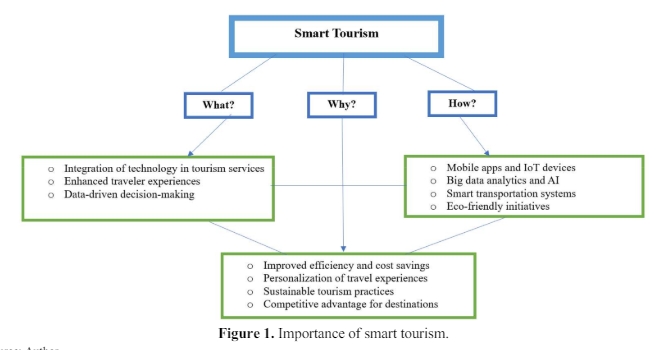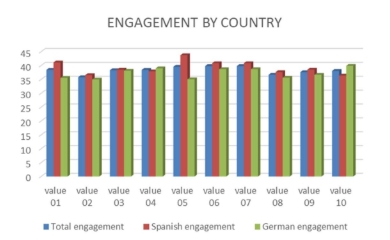


Survey on some key technologies of virtual tourism system based on Web3D
Vol 2, Issue 2, 2021
Download PDF
Abstract
Some key technologies on how to build large-scale virtual tourism systssems comprehensively on Web browsers and mobiles were analyzed and the current R&D status on Web3D virtual tourism was surveyed insightfully. Then, some methods were summarized, including 3D trees or plants modeling, 3D architectural modeling, 3D Virtual Human behavior modeling, virtual agents path planning, collision detection and progressive transmission strategy suitable for developing large scale Web3D tourism scenarios. Also, some bottleneck problems of Web3D virtual tourism system were investigated. At the same time, the lightweight 3D engine, the lightweight 3D modeling, the lightweight 3D streaming and P2P based progressive transmission of huge Web3D tourism contents would become much helpful to breakthrough those bottlenecks of Web3D tourism systems were pointed out. In addition, all kinds of Web3D engines in terms of lightweight, realism and efficiency that would be a good reference for developers to choose during various applications were compared comprehensively. Finally, the prospect of future investigation of Web3D tourism system is presented, which will be going on in terms of four characteristics lightweight, high-speed, realism, beauty.
Keywords
References
- Linden Research Incorporated. Second life network virtual platform [Internet]. 2014. Available from: http://www.secondlife.com.
- Baidu Encyclopedia. Virtual Forbidden City [Internet]. 2014. Available from: http://baike.baidu.com/view/1914659.htm.
- Flying Carpet Technology Co., Ltd. Smart Lijiang 3D tourism platform [Internet]. 2014. Available from: http://www.3dlvyou.com/scene/17486.
- Okabe M, Igarashi T. 3D modeling of trees from freehand sketches. SIGGRAPH03: Special Interest Group on Computer Graphics and Interactive Techniques; 2003 Jul 27-31; San Diego California. New York: ACM; 2003.
- Okabe M, Owada S, Igarashi T. Interactive design of botanical trees using freehand sketches and example-based editing. Computer Graphics Forum 2005; 24(3): 487–496.
- Livny Y, Yan FL, Olson M, et al. Automatic reconstruction of tree skeletal structures from point clouds. ACM Transactions on Graphics 2010; 29(6): 151–158.
- Tan P, Fang T, Xiao J, et al. Single image tree modeling. ACM Transactions on Graphics 2008; 27(5): 108–116.
- Neubert B, Franken T, Deussen O. Approximate image-based tree-modeling using particle flows. ACM Transactions on Graphics 2007; 26(3): 88–97.
- Karwowski R, Prusinkiewicz P. The L-system-based plant-modeling environment L-studio 4.0 [Internet]. 2014. Available from: http://algorithmicbotany.org/papers/lstudio.fsmp2004.pdf.
- Zhang H, Hua W, Wang Q, et al. Hierarchical depth puzzle set: A new method for rapid drawing of trees. Chinese Journal of Image and Graphics 2004; 9(10): 1216–1222.
- Kim J, Cho H. Efficient modeling of numerous trees by introducing growth volume for real-time virtual ecosystems. Computer Animation and Virtual Worlds 2012; 23(3–4): 155–165.
- Livny Y, Pirk S, Cheng ZL, et al. Texture-lobes for tree modeling. ACM Transactions on Graphics 2011; 30(4): 53–64.
- Cheng Z, Yan F, Chen B. Fast 3D modeling of trees based on lobe representation. Journal of Computer Aided Design and Graphics 2012; 24(1): 2–4.
- Sun R, Jia J, Li H. Image-based lightweight tree modeling. Proceedings of the 8th International Conference on Virtual Reality Continuum and its Applications in Industry; 2009 Dec 14-15; Yokohama Japan. New York: ACM; 2009. p. 17–22.
- Dai W, Yang Y, Jia J. Lightweight construction of Web3D forest model based on rules. Computer Engineering and Application 2012; 48(11): 189–195.
- Bellotti F, Berta R, Cardona R, et al. An architectural approach to efficient 3D urban modeling. Computers & Graphics 2011; 35(5): 1001–1012.
- Funge J, Tu X, Terzopoulos D. Cognitive modeling: Knowledge, reasoning and planning for intelligent characters. SIGGRAPH99: Proceedings of the 26th Annual Conference on Computer Graphics and Interactive Techniques; 2002 Jul 23-26; San Antonio Texas. New York: ACM; 1999. p. 29–38.
- H-Anim. Org. Specification for a Standard VRML Humanoid [Internet]. 2014. Available from: www.h-anim. org.
- Ieronutti L, Chittaro L. A virtual human architecture that integrates Kinematic, physical and behavioral aspects to control h-anim characters. Proceeding of the Tenth International Conference on 3D Web Technology; 2005 Mar 29-Apr 1; Bangor. New York: ACM; 2005. p. 75–84.
- Mao T, Wang Z. Fast modeling method of personalized 3D human model. Journal of Computer Aided Design and Graphics 2005; 17(10): 2191–2195.
- Shu B, Mao T, Xu W, et al. A real-time 3D visualization method of large-scale population based on sampling points. Computer Research and Development 2008; 45(10): 1731–1738.
- Shu B, Qiu X, Wang Z. Overview of image-based geometric modeling technology. Computer Research and Development 2010; 47(3): 549–560.
- Luo Y, Sun J, Chen T. Research on behavior model of virtual tour guide. Journal of Engineering Graphics 2011; 5: 35–39.
- Gan J, Peng Q, Dai P, et al. Improved algorithm for collision detection based on OBB hierarchy. Journal of System Simulation 2011; 23(1): 2619–2173.
- Chang M, Luo Z, Li D, et al. Fast collision detection algorithm for virtual environment roaming. Journal of Huazhong University of Science and Technology 2006; 36(11): 7–10.
- He Z, Tian J, Li T, et al. Motion fusion of virtual human walking. Computer Engineering 2009; 35(22): 267–271.
- Zhang Y, Dai Q, Guo F. Vector based fast collision detection algorithm in virtual roaming environment. Computer Engineering 2011; 37(21): 270–272.
- Ieronutti L, Ranon R, Chittaro L. Automatic derivation of electronic maps from x3d/vrml worlds. Proceedings of Web3D 2004: 9th International Conference on 3D Web Technology; 2004 Apr 5-8; Monterey California. New York: ACM; 2004. p. 61–70.
- Torchelsen RP, Scheidegger LF, Oliveira GN, et al. Real-time multi-agent path planning on arbitrary surfaces. Proceedings of the 2010 ACM SIGGRAPH Symposium on Interactive 3D Graphics and Games; 2010 Feb 19-21; Washington D.C. New York: ACM; 2010. p. 47–54.
- Yin B, Xu Z, Kong D, et al. Real time crowd path planning based on voronoi diagram. Journal of Beijing University of Technology 2009; 35(8): 1115–1121.
- Sud A, Andersen E, Curtis S, et al. Real-time path planning in dynamic virtual environments using multiagent navigation graphs. Transactions on Visualization and Computer Graphics 2008; 14(3): 526–538.
- Gayle R, Manocha D. Navigating virtual agents in online virtual worlds. Proceedings of the Web3D; 2008; New York. New York: ACM; 2008. p. 53–56.
- Helbing D, Molnar P. Social force model for pedestrian dynamics. Physical Review: E (S1539-3755) 1995; 51(5): 4282–4286.
- Chim J, Lau RWH, Leong V. Cyberwalk: A Web-based distributed virtual walkthrough environment. Transactions on Multimedia 2003; 5(4): 503–515.
- Wang W, Jia Ji, Zhang C, et al. Research progress of progressive transmission of large-scale virtual scene. Computer Science 2010; 37(2): 38–43.
- Hoppe H. Efficient implementation of progressive meshes. Computers & Graphics 1998; 22(1): 27–36.
- Lang B, Fang J, Han C, et al. Real time roaming of large-scale network terrain based on streaming progressive transmission. Journal of System Simulation 2010; 22(2): 429–434.
- Li Q, Wang G. Progressive transmission method of 3D model in digital museum. Computer Engineering 2006; 32(19): 221–223.
- Wen L, Jia J. Lightweight modeling algorithm based on cell reuse mechanism. Journal of System Simulation 2012; 24(1): 64–71.
- Chim J, Lau RWH, Leong V. Cyberwalk: A Web-based distributed virtual walkthrough environment. IEEE Transactions on Multimedia 2003; 5(4): 503–515.
- Li Tsai-Yen, Hsu Wen-Hsiang. A data management scheme for effective walkthrough its large-scale virtual environments. Visual Computer 2001; 20(10): 626–634.
- Cucchiara R, Piccardi M, Prati A. Neighbor cache prefetching for multimedia image and video processing. IEEE Transactions on Multimedia 2004; 6(4): 539–552.
- Cevikbas SB, Koldas G, Lsler V. Prefetching optimization for distributed urban environments. 2008 International Conference on Cyberworlds; 2008 Sep 22-24; Hangzhou. New York: IEEE; 2008. p. 340–348.
- Virtools [Internet]. 2014. Available from: http://www.3ds.com/products/3dvia/3dvia-virtools/
- Unity Technologies Inc. Unity3D [Internet]. 2014. Available from: http://unity3d.com/
- Act-3D. Quest3d [Internet]. 2014. Available from: http://www.quest3d.com/
- Zhongshidian Technology Co., Ltd. VRP [Internet]. 2014. Available from: http://www.vrp3d.com/
- Beijing Zhongtian Haojing Network Technology Co., Ltd. Converse 3D [Internet]. 2014. Available from: http://www.converse3d.com/
- Tan Y, Jia J, Li G, et al. Research progress of 3D tree modeling technology. Chinese Journal of Graphics and Image 2013; 18(11): 1520–1528.
- Tan Y, Jia J, Kang Y, et al. Architecture design of Jinggangshan virtual tourism system based on webvr. Journal of Jinggangshan University 2012; 33(6): 46–50.
- Yan F, Liu C, Jia J. Analysis and research on key technologies of mainstream flash3d engines. Journal of System Simulation 2013; 25(10): 2263–2270.
Supporting Agencies
Copyright (c) 2021 Yulan Tan, Jinyuan Jia, Shuo Peng, Anmin Huang, Guangyao Li
License URL: https://creativecommons.org/licenses/by/4.0

This site is licensed under a Creative Commons Attribution 4.0 International License (CC BY 4.0).

Prof. Hung-Che Wu
Nanfang College, Guangzhou
China
Indexing & Archiving
Asia Pacific Academy of Science Pte. Ltd. (APACSCI) specializes in international journal publishing. APACSCI adopts the open access publishing model and provides an important communication bridge for academic groups whose interest fields include engineering, technology, medicine, computer, mathematics, agriculture and forestry, and environment.



.jpg)
.jpg)

.jpg)

